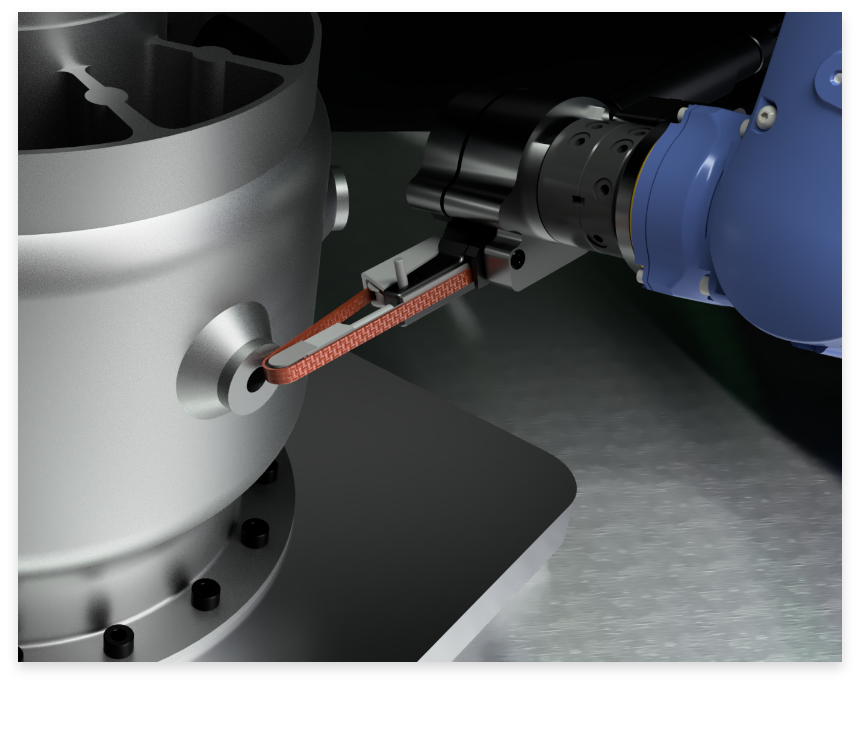UK-based Rivelin Robotics is working on creating a manufacturing cell to automate the post-processing of metal 3D printed parts. If successful, this approach could reduce the costs of metal 3D printed components and decrease the labor required to finish parts. Now, the firm has received additional funding for this project from the UK Research and Innovation’s MSI Challenge, distributed by Innovate UK, the Engineering and Physical Sciences Research Council, and the Economic and Social Research Council. The funding is for the designated Project Certified Additive Manufactured Parts Finished with Intelligent Robotics Engine (CAMPFIRE). In total, £3.7 million were distributed, but the specific amount awarded to Rivelin Robotics for the project is not disclosed.
 Rivelin Robotics will collaborate with GKN Aerospace, Siemens Energy’s 3D printing service Materials Solutions, patient-specific implant manufacturer Attenborough Medical, robot arm company Yaskawa, and materials giant Saint-Gobain in this project. Rivelin’s Netshape robots will be rigorously tested for use in medical, aerospace, automotive, and defense manufacturing. The key challenge is to determine whether the robots can finish parts to the strict tolerances and requirements demanded by these industries.
Rivelin Robotics will collaborate with GKN Aerospace, Siemens Energy’s 3D printing service Materials Solutions, patient-specific implant manufacturer Attenborough Medical, robot arm company Yaskawa, and materials giant Saint-Gobain in this project. Rivelin’s Netshape robots will be rigorously tested for use in medical, aerospace, automotive, and defense manufacturing. The key challenge is to determine whether the robots can finish parts to the strict tolerances and requirements demanded by these industries.
“The support from Innovate UK has been pivotal in accelerating Rivelin Robotics’ journey. The funding not only catalyses the development of our innovative platform, but also empowers us to tackle complex challenges in additive manufacturing. This grant is a key enabler in our mission to revolutionise robotic finishing of near-net-shape parts, enhancing the UK’s position in advanced manufacturing,” said Rivelin Robotics CEO Robert Bush.
 Rivelin Robotics currently has three robotic solutions: the NS0, designed for educational purposes; the NS1 production system, which can handle parts weighing up to 600kg and measuring 800mm x 650mm x 600mm; and the NS2, a dual robot unit. In metal components, finishing costs are significant. Parts may require multiple post-finishing steps, which sometimes can exceed the duration of the entire 3D printing process. Often, finishing must be performed manually using bandsaws or flexes, which is not only costly but can also lead to errors.
Rivelin Robotics currently has three robotic solutions: the NS0, designed for educational purposes; the NS1 production system, which can handle parts weighing up to 600kg and measuring 800mm x 650mm x 600mm; and the NS2, a dual robot unit. In metal components, finishing costs are significant. Parts may require multiple post-finishing steps, which sometimes can exceed the duration of the entire 3D printing process. Often, finishing must be performed manually using bandsaws or flexes, which is not only costly but can also lead to errors.
Automation could enhance reliability and repeatability in lengthy, repeated parts finishing processes. While depowdering has seen automated solutions like Solukon machines, and parts can be placed into vibratory and other finishing machines, automation tools for build plate, part, and support removal are limited and scarcely used.
Rivelin’s approach combines 3D scanning, robotics, and various tools, which appears straightforward. However, integrating the positioning of the robot arm, the tool’s functioning, stability, and the part is challenging, particularly for complex components like turbine parts or implants. Yet, if Rivelin successfully implements this technology, it could significantly improve the throughput and yield of metal 3D printing.
It is encouraging to see the UK invest in addressing key bottlenecks in additive manufacturing. Recently, the UK government funded further research into Q5D, a robot cell-based solution for wire harness production. Both this and the projects by Rivelin Robotics cater to a mature 3D printing market and aim to automate labor-intensive processes. They share similar challenges in stability, toolpathing, and 3D scanning. It might be beneficial for the next UK Innovate project to focus on an innovation that could assist both startups.
Subscribe to Our Email Newsletter
Stay up-to-date on all the latest news from the 3D printing industry and receive information and offers from third party vendors.
You May Also Like
Further Understanding of 3D Printing Design at ADDITIV Design World
ADDITIV is back once again! This time, the virtual platform for additive manufacturing will be holding the first-ever edition of ADDITIV Design World on May 23rd from 9:00 AM –...
3D Printer Maker EVO-tech Reborn as NEVO3D — Once More With Feeling
EVO-tech was a 3D printing service and original equipment manufacturer established in 2013 and based in Schörfling am Attersee, Austria. The company produced high-quality material extrusion systems featuring linear bearings,...
3D Systems Brings 3D Printed PEEK Cranial Implant to the U.S. with FDA Clearance
For more than 10 years, 3D Systems (NYSE:DDD) has worked hand-in-hand with surgeons to plan over 150,000 patient-specific cases, and develop more than two million instruments and implants from its...
CDFAM Returns to Berlin for Second Annual Symposium
The second CDFAM Computational Design Symposium is scheduled for May 7-8, 2024, in Berlin, and will convene leading experts in computational design across all scales. Building upon the first event...































